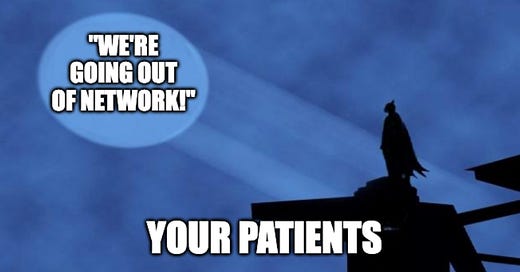Insurance Termination Done Right
“Doing is a quantum leap from imagining.”
-Barbara Sher
Eager to make the leap to cash pay? Wonderful! Your purpose, business model, and staff are on the same page? Magnificent! But it’s hard to run a cash-based clinic… if you still accept insurance. This guide shows how to cut off the health plans.
Today’s TLDR—how to cut health plans
Compile ALL your clinic’s participating networks (use Excel, Google docs, Notion, whatever—just make sure you can share this with your team) including provider relations contact info.
Inquire about the preferred termination process for each plan (e.g. email, fax, certified mail, secure online form). Ask for the effective termination date. Execute.
Confirm with corresponding health plan contacts that your termination was received and is/was processed. Save all related documents.
Decoupling commercial plans
Nearly all insurance companies maintain “provider relations” teams. If your clinic knows a human being managing insurance credentials for a certain network, that point of contact may also handle termination requests (or knows someone who does). When speaking with a plan’s rep, first verify the earliest possible termination date once they find your account. If you participate in a compact involving many health plans, kill the whole flock with one stone. Avoid sending individual terminations for a family of plans. Be persistent. Health plans usually want more physicians in their networks to service more patients (= more premiums). Hence the termination process can be difficult. Document all related correspondence. Yes, even the emails and faxes. Use certified mail with a return confirmation. There are some nuances for commercial plans vs Medicare.
Slaying the Medicare whale
The behemoth that is Medicare gets its own section. Depending on your specialty, Medicare members could be >50% of practice volume. But unlike Captain Ahab, you can slay the whale and live to tell the tale. Medicare’s administrator, Noridian, which handles all Part A and B claims, also oversees termination via an “opt-out” process. Your communication is with Noridian, not Centers for Medicare and Medicaid Services (CMS). Below is an example resource page. Make sure that you select the correct jurisdiction for Medicare part B. For example Oregon, where I operate, is in Jurisdiction F.
If you wish to leave Medicare, mail an opt-out affidavit (PDF is linked below). Said affidavit must be postmarked at least 30 days prior to day 1 of the next quarter. Don’t miss that train. Noridian also states certain mailing addresses depending on your state (use the captioned link above to learn more). Medicare opt-out periods last for TWO YEARS. Quadruple check this paperwork. Noridian might ask for more information—you’ll have 30 days to respond. You can appeal a decision if needed. Medicare will send you a confirmation with the exact two-year period. Renewals are automatic. Medicare usually sends physical mail near the opt-out window’s end date to confirm. If you want to sign back on with Medicare, submit a cancellation request 30 days before the opt-out period ends.
So now you’re free of Medicare’s oversight
Good stuff. But as Kobe Bryant once said, “job’s not finished.” When Medicare patients visit anytime during an opt-out period, they must sign a private pay contract with you (PDF embedded below). This document formally lets patients say “I’m cool seeing Dr. XYZ without Medicare.” Both your office and the patient cannot send a claim to Noridian for any covered services. The private pay agreement needs to be renewed every two years (in line with the opt-out period). Use your preferred EMR or practice management software to track this.
Tying off termination—don’t whistle past the payers!
Track the effective termination dates in your master calendar—make sure this is in accordance with your cash pay transition timeline. Save all relevant documents. As you know, insurers aren’t efficient all the time (certainly not when they’re supposed to pay or cover you). Sometimes health plans you terminated may continue to send correspondence as if you are in-network. Be clear with the health plans and your patients about this. You got this! Care to Cash is here to guide you through the private pay journey. Reach us on our Substack or contact me @caretocash on x.com to address questions for your practice.






